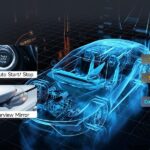Connecting an OBD2 scanner to your car should be a simple process, but sometimes it can be frustrating when the scanner won’t connect. If you’re seeing a “No Communication” error message, don’t worry. This guide will walk you through common reasons why your OBD2 scanner won’t connect to your car and provide troubleshooting steps to get you back on track.
Common Causes of OBD2 Connection Problems
Several factors can contribute to OBD2 scanner connection issues. Here are some of the most frequent culprits:
1. Ignition Key Position
Ensure your car’s ignition key is in the “Run” position (sometimes labeled “On”). The scanner needs power from the car’s electrical system to communicate with the Engine Control Unit (ECU). In some vehicles, the engine may need to be running. Wait for all dashboard warning lights and chimes to cease before attempting to connect the scanner, as the car’s systems may still be booting up.
2. Low or No Voltage at the OBD2 Port
Your OBD2 port needs sufficient voltage to power the scanner. Using a voltmeter, check pin 16 for 12 volts and pins 4 and 5 for ground. If the voltage is significantly below 12 volts or absent, a blown fuse might be the issue. Consult your car’s owner’s manual to locate and replace the relevant fuse.
3. OBD2 Scanner Compatibility
While most modern cars use standardized OBD2 protocols, some older vehicles or those with manufacturer-specific systems might require a specialized scanner. Ensure your scanner supports the protocols used by your car. Consider a multi-system diagnostic scanner with OBD1 and OBD2 compatibility for broader vehicle coverage.
4. ECM Communication Issues
Sometimes, the car’s ECM (Engine Control Module) might get stuck in a non-communicative state. Try rebooting the ECM by disconnecting the battery’s negative terminal for a few minutes. This can clear any temporary glitches and restore communication. Always consult your car’s owner’s manual before disconnecting the battery.
5. Missing or Invalid Data
Your scanner might be using outdated or incorrect data for your car model. Try refreshing or updating the scanner’s vehicle definitions or performing a PID (Parameter ID) scan to ensure it’s using the correct data for your car.
Advanced Troubleshooting Tips
If the basic steps haven’t resolved the issue, consider these more advanced troubleshooting techniques:
- Check for Damaged Wiring: Inspect the OBD2 port and its wiring for any signs of damage, corrosion, or loose connections.
- Consult Your Car’s Manual: Your owner’s manual might provide specific instructions for using diagnostic tools with your car model.
- Seek Professional Help: If you’ve exhausted all troubleshooting options, consult a qualified mechanic or automotive technician.
Conclusion
Troubleshooting an OBD2 scanner connection problem often involves checking simple things like the ignition key position and voltage at the OBD2 port. Understanding potential compatibility issues and ECM communication problems can also help you resolve connection difficulties. If the problem persists, remember that professional help is always available. Choosing a reputable supplier for your diagnostic tools can also provide valuable support in troubleshooting future issues.

